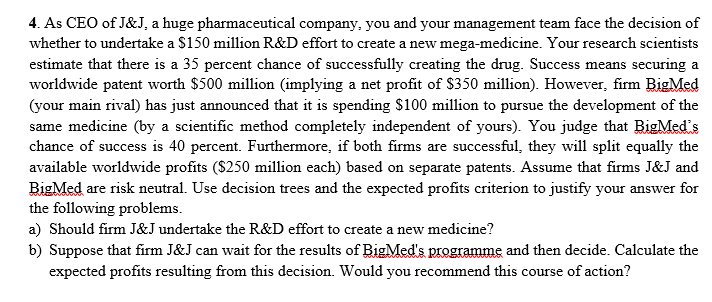As CEO of J&J, a huge pharmaceutical company, you and your management team face the decision of whether to undertake a $150 million R&D effort to create a new mega-medicine. Your research scientists estimate that there is a 35 percent chance of successfully creating the drug. Success means securing a worldwide patent worth $500 million (implying a net profit of $350 million). However, firm BigMed (your main rival) has just announced that it is spending $100 million to pursue the development of the same medicine (by a scientific method completely independent of yours). You judge that BigMed’s chance of success is 40 percent. Furthermore, if both firms are successful, they will split equally the available worldwide profits ($250 million each) based on separate patents. Assume that firms J&J and BigMed are risk neutral. Use decision trees and the expected profits criterion to justify your answer for the following problems. Should firm J&J undertake the R&D effort to create a new medicine? Suppose that firm J&J can wait for the results of BigMed's programme and then decide. Calculate the expected profits resulting from this decision. Would you recommend this course of action?
As CEO of J&J, a huge pharmaceutical company, you and your management team face the decision of whether to undertake a $150 million R&D effort to create a new mega-medicine. Your research scientists estimate that there is a 35 percent chance of successfully creating the drug. Success means securing a worldwide patent worth $500 million (implying a net profit of $350 million). However, firm BigMed (your main rival) has just announced that it is spending $100 million to pursue the development of the same medicine (by a scientific method completely independent of yours). You judge that BigMed’s chance of success is 40 percent. Furthermore, if both firms are successful, they will split equally the available worldwide profits ($250 million each) based on separate patents. Assume that firms J&J and BigMed are risk neutral. Use decision trees and the expected profits criterion to justify your answer for the following problems.
- Should firm J&J undertake the R&D effort to create a new medicine?
- Suppose that firm J&J can wait for the results of BigMed's programme and then decide. Calculate the expected profits resulting from this decision. Would you recommend this course of action?

Trending now
This is a popular solution!
Step by step
Solved in 4 steps with 2 images




